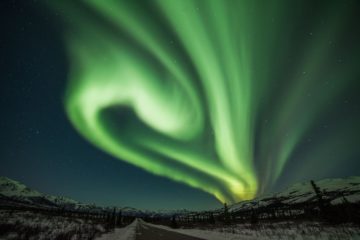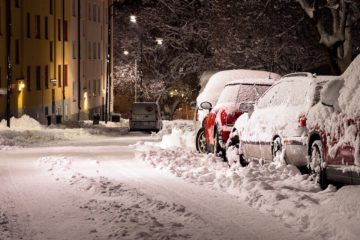Soundtrack in my head: Point of Grace, “Carol of the Bells/What Child Is This?”

Even before I moved to Wisconsin, I’d always kept in my mind this image of a nighttime aerial view of Wisconsin’s hills stretching out as far as the eye could see, sleeping peacefully under a blanket of snow and dotted with the lights of scattered dwellings and Christmas decorations here and there.
The road to Madison
Earlier this month as I was driving back home from Chicago, the beauty of the landscape struck me. Just north of Janesville, Interstate 39/90 starts to cut northwest towards Madison, and the terrain becomes quite hilly and begins to look a lot like this pastoral picture postcard in my head. As I was driving north that one evening, the snow-covered hills were glowing under the moonlight, and here and there I could see farm houses and small developments lit up by Christmas lights. The landscape perfectly complemented this folk Christmas CD I was listening to that was getting me in the mood for the season.
The pastoral scene was interrupted by Madison’s Beltline Highway which cuts a wide and busy path along the southern edge of the city. But when I exited the Beltline at John Nolen Drive and saw the Christmas lights display along Olin Turville Park, I decided to maintain my Christmas spirit by taking a little driving tour of the displays. Each year, a local union puts up these displays along a curvy park road that people drive through, admiring the decorations from the comfort of their cars. Local businesses sponsor these Christmas light sculptures ranging in size from six to fifteen feet in height, and one can see images of Santa, Christmas trees, and yes, even football helmets of the University of Wisconsin Badgers and Green Bay Packers.
Ugly Christmas decorations

These decorations are a nice contrast to a different sort of Christmas decoration I used to see when I lived in Chicago. After heavy snowfalls, Chicagoans have had this tradition of decorating the streets with orange cones, folding chairs, broomsticks, and other implements of obstruction designed to keep others from taking the on-street parking space they just shoveled. Where I used to live in Chicago, there were barely enough parking spaces to accommodate the cars in the neighborhood. So, when people staked their private claims on a public parking space, they rendered many of the spaces unusable for many hours per day, thus reducing the number of available parking spaces in the neighborhood and making it hard for the rest of the neighbors. I kept hoping that Chicago’s mayor would take the high ground and ask Chicagoans to stop staking private claims on public property, but instead, Mayor Richard M. Daley referred to this practice as a “time-honored Chicago tradition.” I think that’s one reason why I live in Wisconsin now.
I prefer a different time-honored tradition: In December 2000, Chicago was hit with some twenty inches of snow or so in the space of one week. During the second snowfall, about a week before Christmas, the snow was so bad that it took me 1 1/2; hours to drive just six miles back to my neighborhood, a drive that would normally take thirty minutes.
When I got to my block, almost all the parking spaces were open, since I’d gotten home well before rush hour, but the spaces were not accessible because the while the middle of the street was drivable, the snow in the parking spaces was already too deep to drive through. Luckily, I found a spot that someone had cleared near the end of the block. However, as I was walking to my apartment, I noticed that my neighbors weren’t quite so lucky—many were wandering around in their cars because there was no place to park.
Cooperate, not compete
I’m normally not that altruistic of a person, but I could see just how chaotic things were about to get with rush hour approaching, so I grabbed my shovel and started digging a spot in front of my building. Within 20 minutes I had a new space freshly cleared and I began working on the space next to it. Many cars looking for spaces passed me by—no one seemed to even consider that I might be digging out a space for them. At one point, I tried to get the attention of some friends of mine who lived below me who were driving by, but they couldn’t see me. Finally, two young women from the building across the alley from me pulled in, grateful and somewhat incredulous that someone would just clear spaces for people like that.
Two older Latina women who lived two stories directly below me pulled into the next space I dug out. I never really knew them, but would often exchange hellos with them in the hallway. But within a few minutes they were back outside, bundled up and ready to help with their own shovels. One of them was about a foot shorter than me, and I could barely see her under her winter clothing—it was mostly coat and scarf and hat and shovel.
This cooperative mindset seemed to spreading like a virus now at my end of the block. We cleared another space and a tall guy with short red hair pulled in. I seemed to recognize him as someone who had helped push out some people who were stuck the day before. In fact, he casually mentioned that he helped someone else dig out their car and pointed to the car he helped dig out. It was my sister’s, who lived in the same building as me.
After a couple of hours of this and clearing about a fifth of the block, we thanked each other and went back inside. I had an unusually warm feeling my heart as I watched the snow tumble down to the ground from the comfort of my apartment. I knew that what we were doing was really how people were meant to interact in the city and elsewhere, and it felt good to create that better world in our little corner of the city, even if it was just for a couple of hours.
It’s been five years since that little shoveling party. I now live in Madison, Wisconsin in a co-op house with the goal of making community living and cooperation a way of life. It’s not necessarily that much easier to foster cooperation here. But as I begin to take my lifestyle for granted, this little story reminds me of why I’ve made the choices that I made, and that a better world is a bit closer than we might think sometimes.
Epilogue: A couple of days after our shoveling party in December 2000, I got word that 4-8 more inches of more snow was expected. I had to move my car because it was parked on a main street, which was a snow route during snowfall and it had to be moved aside for the plows. I was worried about being able to find another spot because despite our little shoveling party, there were still many people jealously guarding the parking spots they dug out. But to my amazement, I found an open spot right in front of my building. It was the first one I had dug out a couple of days before…
